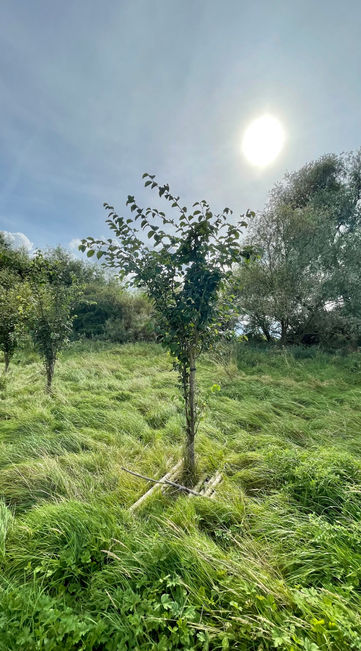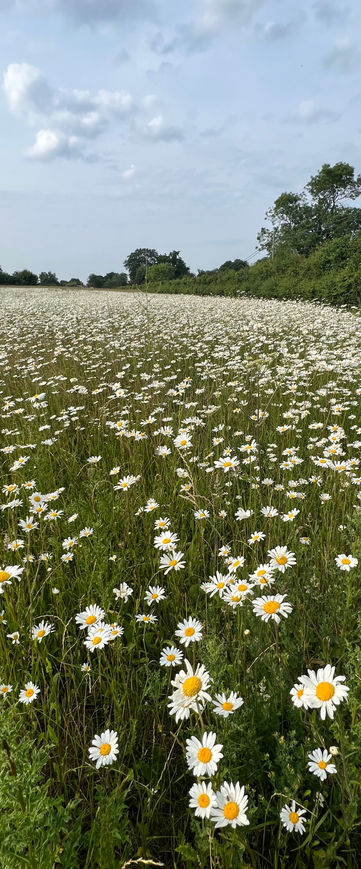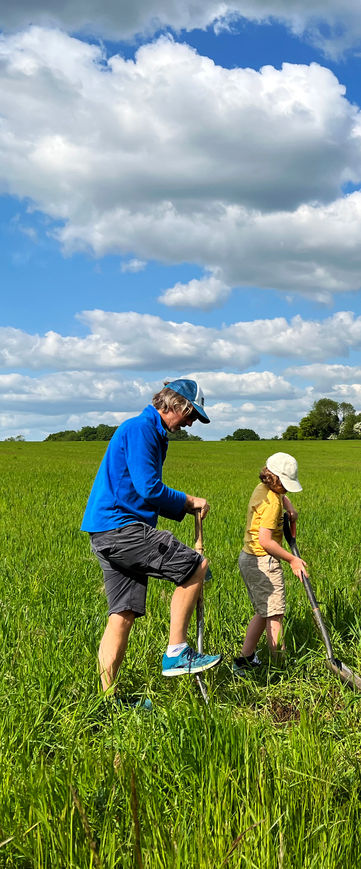

Stories
Lifestyle and Conservation
We do not have any formal or really any informal education in conservation but we have found that there are many people who do have expertise and want to help. Physical conservation work is fun, social and teaches you things you would never know just by walking by. While the projects and their many natural residents are largely left to themselves we love to spend time with family and friends on the land, camping, picnicking, filming, playing etc. as well as engaging in actual conservation.
Bee Field is a 7.6 acre field in the flood plain of the river Great Ouse in Cambridgeshire. It is a magical place and full of wildlife. It is adjoined on two sides by nature reserves with lakes ringed by willows, reedbeds and water meadows. You reach it via a long dirt track. Some incredibly successful self planted willows have taken over the entrance and a hard standing that was created there which makes it feel like you are entering another dimension when you go through the gate.
The owners until 2020 (who are bee keepers; hence the name) planted two hundred fruit trees including apples, pears, cherries, plums, medlars and quinces. In addition, they planted more than an acre of mixed native deciduous trees in association with the Woodland Trust in 2019:
Tree Species and quantities
Aspen (100),Crab Apple (100),Hornbeam 50, Oak (100), Rowan(100) Silver Birch (100), Sweet Chestnut (25), Walnut (25) Wild Cherry (100)
Total
700
Shrub Species and quantities
Blackthorn (25), Dog Rose (50), Elder (75),Hazel (100),Holly (50)
Total
300
After some dry summers and winters during which much of the field has been under water, survival rates among the original trees have been variable. We do not clear the land around the trees so they have to compete with grasses (which grow tall) and more recently thistles. The majority of the fruit trees were not suited for waterlogged ground and all trees are preyed on by a large population of deer including muntjac. Only one cherry tree and one plum tree have survived of the original one hundred trees. However, some of the other trees including silver birch, alder, blackthorn and oak have thrived and the yield of apples, pears, quinces and medlars is increasing.
In February 2022, we planted several hundred willow, alder, silver birch, poplar and other trees. Again, we have found them to be much more successful in some areas of the field (particularly the margins) than others:
Tree Species and quantities
Malus sylvestris (10), Corylus avellana (20), Alnus glutinosa (50), Salix viminalis (70), Populus nigra (30), Prunus spinosa (30), Betula pubescens (20), Prunus d. 'Damson' Bush (2), Prunus d. 'Hauszwetsche' Bush (2),Prunus a. 'Sunburst' Bush (40)
Total
274
We have also planted several additional fruit trees over the past two years in the better drained areas of the field with generally good results. We have noted that the quality of trees seems to vary greatly depending on where they are sourced. We have experimented with a variety of vegetables. The key criteria here is that we are not able to look after them regularly so they suffer from lack of water and weeding and receive attention from rabbits (no small blue jackets with brass buttons have been discovered yet) and other animals. The stand out success in the vegetable category has been potatoes although we have also grown salads, herbs, broad beans, cauliflower and courgettes. Innumerable other crops have fallen by the way side as we experimented.We have planted bulbs in various areas with beautiful results.The hedges naturally yield a magnificent crop of blackberries every year.
Finally, the land contains a pond and a duck decoy (which is effectively a winter lake and small pond in summer). We have cleared out both which has led to a burst in new visitors to the land including mallards, snipe and other waders, herons and egrets.
Rose and Lion Wood is a 70 acre site in the north of Hertfordshire. I grew up in a village nearby and our school bus drove past the field every day. As a child I was fascinated by the woods (which were mainly the domain of pheasants for shooting) and longed for more places to play. This was also the time when agriculture was becoming more industrial and hedgerows were being ripped out everywhere.
The land, which sits near the edge of the Chiltern hills, is currently given over to grass and wildflowers while we work on an application for an England Woodland Creation Offer grant from the Forestry Commission which should pay for deer fencing and the planting of 28,000 native deciduous trees.While this place is only 30 miles from north London, it feels like a different world with green lanes and idyllic villages.
We are working closely with the Woodland Trust who have been incredibly helpful in advising us and completing the highly complex paperwork.
In terms of horticulture we have started small; planting 6 fruit trees in the winter of 2023 and by digging a small pond.













































